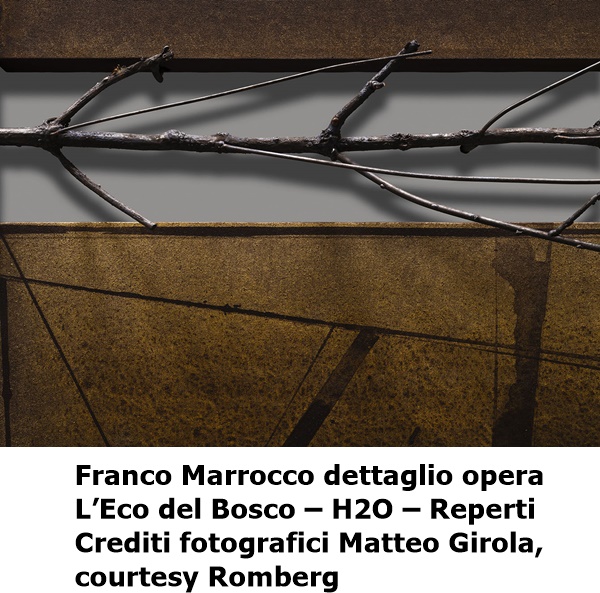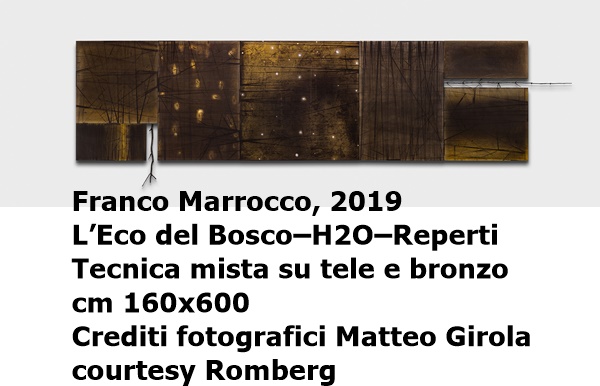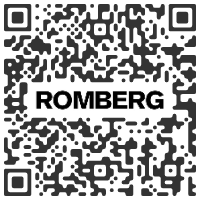"The Echo of the Wood, H2O, Artefacts"
Franco Marrocco
curated by Massimo Bignardi

ROOMBERG
VIALE LE CORBUSIER 39 Baccari Skyscraper- ground floor 04100 LATINA ITALYT (+39) 0773 604788 M (+39) 334 710 5049 e-mail:

October 19th > November 10th, 2019


Saturday, October 19, 2019, Romberg Arte Contemporanea presents its second appointment as part of the “Carte d’Identità” exhibition, curated by Italo Bergantini and Gianluca Marziani. The imposing installation proposed by Franco Marrocco, designed specifically for the gallery space, reproposes the dialogue between the pictorial plane, architectural overhangs with bronze sculptural insertions and the object in its everyday dimension.
"The strong point - writes Massimo Bignardi (curator of the exhibition) - that we can record in these last great paintings that the artist has inscribed in the cycle “the Eco of the wood - H2O ", among which the great installation proposed in the Pavilion of the People's Republic of Bangladesh of today's Venice Biennale, is the time that holds together the expectation and the epiphanic appearance of the image. A time of reflection and, at the same time, of affirmation of instinct, not in contrast, but responding to a catharsis that thought puts into being, resting, momentarily, in a place within the invisible world.
This happens in a pictorial space that, following the partition of the pictorial planes like a retablo, houses backdrops laden with shadows lit here and there by the flashes of an unknown galaxy, with the imprints left by branches, with sculptural bodies that creep into the recesses built and conceived as places of rest (from where to hide from time): places not of the forest, but from the echo that stirs the conscience of the artist. The irregular architecture of the canvas, organized according to a plastic articulation of planes and shadows, thus the recaptured chromatic system, now once again dense with burnished and reddish veils, then the recourse to a perspective left free to move between appearance and reality (the object in its nature of presence), recall two essential characteristics of an identity typical of Italian painting.
The greatest evidence is given by the quality of the painting, its grammar and, above all, the compositional syntax. Qualities that, right from his first works, when the artist was looking at expressionist realism mediated by suggestions taken from the registers of the New figuration (I'm thinking of the canvases of the early Eighties), codified his experience. It is a dictation of identity that is also manifested in the resumption of a lyrical abstraction, typical of Italian painting immediately after the Second World War, with obvious inclinations on the informal side.
Here is the choice then, and not one to put into the background, whether to adhere to a process belonging to the avant-gardes that marked the art of the twentieth century: a process, in my opinion that was not interrupted by the postmodern condition, by a season fortunately left behind. Marrocco, after having eliminated the thickness of colour, significantly present in the paintings of the late nineties, began to reflect on how to offer the eye a multiplicity of planes and therefore of spaces, resorting to the illusion dictated by veiling, from the crystalline overlap of layers of transparent paint. All this was not enough; he understood how to go beyond, and the exceptional canvas The echo of the wood, H2O, artefacts which he is exhibiting on the great wall of the gallery in Latina, leaning outwards, is proof of this. It brings us back to the identity of the avant-garde where reality, imagination support the essence of life.
"The strong point - writes Massimo Bignardi (curator of the exhibition) - that we can record in these last great paintings that the artist has inscribed in the cycle “the Eco of the wood - H2O ", among which the great installation proposed in the Pavilion of the People's Republic of Bangladesh of today's Venice Biennale, is the time that holds together the expectation and the epiphanic appearance of the image. A time of reflection and, at the same time, of affirmation of instinct, not in contrast, but responding to a catharsis that thought puts into being, resting, momentarily, in a place within the invisible world.
This happens in a pictorial space that, following the partition of the pictorial planes like a retablo, houses backdrops laden with shadows lit here and there by the flashes of an unknown galaxy, with the imprints left by branches, with sculptural bodies that creep into the recesses built and conceived as places of rest (from where to hide from time): places not of the forest, but from the echo that stirs the conscience of the artist. The irregular architecture of the canvas, organized according to a plastic articulation of planes and shadows, thus the recaptured chromatic system, now once again dense with burnished and reddish veils, then the recourse to a perspective left free to move between appearance and reality (the object in its nature of presence), recall two essential characteristics of an identity typical of Italian painting.
The greatest evidence is given by the quality of the painting, its grammar and, above all, the compositional syntax. Qualities that, right from his first works, when the artist was looking at expressionist realism mediated by suggestions taken from the registers of the New figuration (I'm thinking of the canvases of the early Eighties), codified his experience. It is a dictation of identity that is also manifested in the resumption of a lyrical abstraction, typical of Italian painting immediately after the Second World War, with obvious inclinations on the informal side.
Here is the choice then, and not one to put into the background, whether to adhere to a process belonging to the avant-gardes that marked the art of the twentieth century: a process, in my opinion that was not interrupted by the postmodern condition, by a season fortunately left behind. Marrocco, after having eliminated the thickness of colour, significantly present in the paintings of the late nineties, began to reflect on how to offer the eye a multiplicity of planes and therefore of spaces, resorting to the illusion dictated by veiling, from the crystalline overlap of layers of transparent paint. All this was not enough; he understood how to go beyond, and the exceptional canvas The echo of the wood, H2O, artefacts which he is exhibiting on the great wall of the gallery in Latina, leaning outwards, is proof of this. It brings us back to the identity of the avant-garde where reality, imagination support the essence of life.
 | Franco Marrocco |
opening : Saturday October 19th 2019 6 p.m.
QR of this press release
in your phone, tablet








